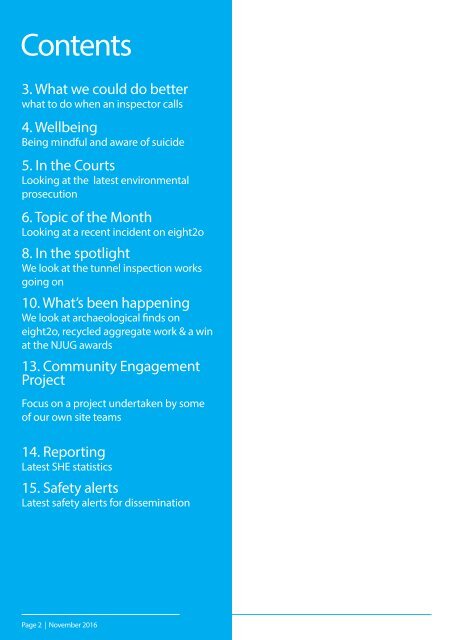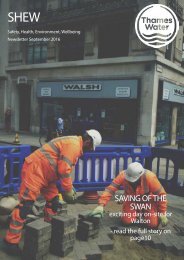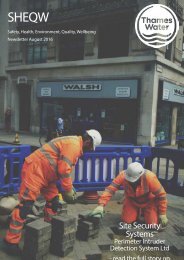SHEQWs Newsletter November
Create successful ePaper yourself
Turn your PDF publications into a flip-book with our unique Google optimized e-Paper software.
Contents<br />
What we could do better<br />
3. What we could do better<br />
what to do when an inspector calls<br />
4. Wellbeing<br />
Being mindful and aware of suicide<br />
5. In the Courts<br />
Looking at the latest environmental<br />
prosecution<br />
6. Topic of the Month<br />
Looking at a recent incident on eight2o<br />
8. In the spotlight<br />
We look at the tunnel inspection works<br />
going on<br />
10. What’s been happening<br />
We look at archaeological finds on<br />
eight2o, recycled aggregate work & a win<br />
at the NJUG awards<br />
13. Community Engagement<br />
Project<br />
Focus on a project undertaken by some<br />
of our own site teams<br />
14. Reporting<br />
Latest SHE statistics<br />
15. Safety alerts<br />
Latest safety alerts for dissemination<br />
What to do when an inspector calls<br />
What do you need to know about regulators such as the Environment Agency and<br />
HSE?<br />
Regulators such as the EA, HSE and Local Authority are key stakeholders for many eight2O activities and we are<br />
regularly required to engage with them on various issues Including obtaining advice, licences and permits.<br />
Visits with any regulator may be pre-arranged but these regulators are also warranted officers and so if they arrive<br />
on site we are obliged to grant them access. If they deem necessary they can stop work, carry out interviews under<br />
caution, take samples and even issue on the spot fines.<br />
If a visit and evidence leads to them suspecting wrong doing this may lead to further investigation and potential for<br />
further legal action.<br />
What should you do if an inspector attends<br />
your site?<br />
• Ensure that you see a copy of the regulator’s ID and note<br />
down the individuals name.<br />
• Prior to escorting the individual on site, ensure that they<br />
have the necessary PPE, have signed in on the visitor’s<br />
book and have had the necessary visitor’s induction.<br />
• Whilst walking around site ensure that you take photos<br />
of the same areas as the inspector.<br />
• Take notes of who spoke to the inspector and an outline<br />
of the discussion.<br />
• If they take samples, for example of discharged water,<br />
ensure that the site take a duplicate sample at the<br />
same time. This will ensure that we are able to send the<br />
sample off for independent testing.<br />
• If documents are requested and taken please ensure<br />
copies are available or taken prior to them leaving site.<br />
• If documents or samples are collected, the site should<br />
be given a chain of custody to sign. This chain of custody<br />
states that the sample was witnessed being taken by the<br />
inspector at a specified location.<br />
• Ensure that one member of the team, usually the Site<br />
or Project Manager, exchanges contact details with the<br />
inspector and becomes the single point of contact for<br />
any future communication. This will enable the team to<br />
build a relationship with the inspector and keep them<br />
informed of any required remedial actions that are<br />
being undertaken.<br />
• DO NOT ask how much money we will be charged for<br />
their time<br />
• DO NOT question the inspector’s suspicions and<br />
conclusions without good evidence.<br />
Page 2 | <strong>November</strong> 2016 SHEW <strong>Newsletter</strong><br />
SHEW <strong>Newsletter</strong><br />
<strong>November</strong> 2016 | Page 3
















